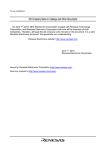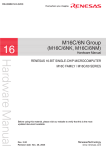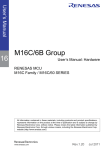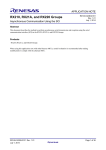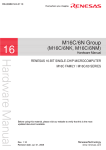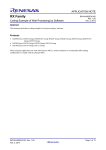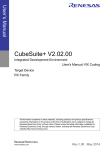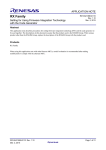Download Audio Design TXi 6000 Specifications
Transcript
APPLICATION NOTE
RX Family, M16C Family
R01AN1859EJ0100
Rev. 1.00
Apr. 1, 2014
Migrating from the M16C to the RX
Asynchronous Serial Communications (UART)
Abstract
This document describes migrating from the serial I/O UART mode in the M16C Family to the SCI asynchronous mode
in the RX Family.
Products
RX Family, M16C Family
When using this application note with other Renesas MCUs, careful evaluation is recommended after making
modifications to comply with the alternate MCU.
Differences in Terminology
Item
Serial communication interface
(SCI)
Asynchronous serial
communications mode
SCI operating clock (clock source)
RX Family
SCI
Asynchronous mode
Clock source
Peripheral function operating clock
Peripheral module clocks:
PCLKA, PCLKB, PCLKC, PCLKD
Transmit buffer
Transmit shift register
Receive buffer
TDR register
TSR register
RDR register
Transmit interrupt
TXI interrupt
Transmit complete interrupt (M16C)
TEI interrupt
Transmit end interrupt (RX)
Receive interrupt
RXI interrupt
Function to select I/O of peripheral
*1
MPC
functions for pins
M16C Family
Serial I/O
UART mode (clock asynchronous
serial I/O mode)
Count source
Peripheral function clocks: f1,
fOCO40M, fOCO-F, fOCO-S,
fC32
UiTB register (transmit buffer)
UART transmit shift register
UiRB register
UARTi transmit interrupt (transmit
buffer empty)
UARTi transmit interrupt
(transmission completed)
UARTi receive interrupt
Function select register,
*2
input function select register
Note 1. Only available in the M32C Group and R32C Group.
Note 2. The MPC is not available in some groups.
R01AN1859EJ0100 Rev. 1.00
Apr. 1, 2014
Page 1 of 15
RX Family, M16C Family
Migrating from the M16C to the RX
Asynchronous Serial Communications (UART)
Contents
1.
Differences in Asynchronous Serial Communications ....................................................................... 3
2.
Peripheral Functions Used ................................................................................................................. 4
3.
Differences in Asynchronous Serial Communications ....................................................................... 4
3.1 Transmit/Receive Timing ............................................................................................................. 5
3.1.1 Differences in Transmitting ................................................................................................... 5
3.1.2 Differences in Receiving ....................................................................................................... 7
3.2 Differences in Setting Procedures ............................................................................................... 9
3.3 Calculating the Bit Rate ............................................................................................................. 12
4.
Appendix ........................................................................................................................................... 13
4.1 Points on Migrating from the M16C to the RX ........................................................................... 13
4.1.1 Interrupts ............................................................................................................................. 13
4.1.2 I/O ports .............................................................................................................................. 13
4.1.3 Module Stop Function ......................................................................................................... 13
4.2 I/O Register Macros ................................................................................................................... 14
4.3 Intrinsic Functions ...................................................................................................................... 14
5.
Reference Documents ...................................................................................................................... 15
R01AN1859EJ0100 Rev. 1.00
Apr. 1, 2014
Page 2 of 15
RX Family, M16C Family
1.
Migrating from the M16C to the RX
Asynchronous Serial Communications (UART)
Differences in Asynchronous Serial Communications
Table 1.1 lists the Differences in Asynchronous Serial Communications.
Table 1.1 Differences in Asynchronous Serial Communications
Item
RX (RX210)
Operation clock source
PCLKB
Data length
7 bits or 8 bits
Selectable from even, odd, or no
parity
1 bit or 2 bits
LSB first or MSB first
Available (selectable)
Not available
Transmit data empty (TXI) interrupt
Transmit end (TEI) interrupt
Receive data full (RXI) interrupt
Receive error (ERI) interrupt
Overrun error
Framing error
Parity error
Available
The signal paths from input on the
RXDn pins incorporate digital noise
filters
Available
Not available
Parity bit
Stop bits
Data format
Hardware flow control
Separate CTS/RTS pins
Interrupt sources
Error detection
Multi-processor function
Noise cancellation
Data logic switch
TXD, RXD I/O polarity switch
R01AN1859EJ0100 Rev. 1.00
Apr. 1, 2014
M16C (M16C/65C)
f1, fOCO40M, fOCO-F, fOCO-S, or
fC32
7 bits, 8 bits or 9 bits
Selectable from even, odd, or no
parity
1 bit or 2 bits
LSB first or MSB first
Available (selectable)
Available (UART0)
Transmit interrupt
Receive interrupt
Overrun error
Framing error
Parity error
Not available
Not available
Available
Available
Page 3 of 15
RX Family, M16C Family
2.
Migrating from the M16C to the RX
Asynchronous Serial Communications (UART)
Peripheral Functions Used
Table 2.1 lists Peripheral Functions and Modes Used When Performing Asynchronous Communications.
Table 2.1 Peripheral Functions and Modes Used When Performing Asynchronous Communications
No.
1
3.
Operating Example
Peripheral
Function
Asynchronous serial
communications
(transmit/receive
operations)
SCI
RX
Mode
Asynchronous
mode
M16C
Peripheral
Mode
Function
Serial I/O
UART mode
Reference
Chapter 3
Differences in Asynchronous Serial Communications
Table 3.1 lists the Conditions for Asynchronous Serial Communications.
Table 3.1 Conditions for Asynchronous Serial Communications
Item
Peripheral function operating clock
Transfer rate
Data length
Stop bits
Parity
Data format
Hardware flow control
Channels used
Pin processing
Conditions for Transmission and Reception
16 MHz
9600 bps
8 bits
1 stop bit
None
LSB first
None
M16C Family: UART0
RX Family: SCI0
*1
Connect pin TXD and RXD to a pull-up resistor
Note 1. In the RX Family, when the SCR.TE bit is 0 (serial transmission is disabled), the TXD pin is in the
Hi-Z state. When a pull-up resistor is not connected, while serial transmission is disabled, switch the
pin function to the output state of general I/O ports.
R01AN1859EJ0100 Rev. 1.00
Apr. 1, 2014
Page 4 of 15
RX Family, M16C Family
3.1
3.1.1
Migrating from the M16C to the RX
Asynchronous Serial Communications (UART)
Transmit/Receive Timing
Differences in Transmitting
Figure 3.1 shows the Differences in Timing When Transmitting 3 Bytes at a Time.
1
TXD pin
M16C
Family *1
Low
TE bit in the
UiC1 register
1
IR bit for the
transmit interrupt
1
SCR.TE bit
SCR.TIE bit
RX
Family
High
0
0
2 3
4
First byte
Second byte
5
6 7
8
Third byte
First byte
Become 0
when an
interrupt is
accepted
1
0
1
0
IEN bit for the
TXI interrupt
1
IR flag for the
TXI interrupt
1
0
0
Become 0
when an
interrupt is
accepted
SCR.TIE bit
IEN bit for the
TEI interrupt
1
IR flag for the
TEI interrupt
1
0
0
Note 1. In the M16C Family, the transmit interrupt source can only be selected from "UiTB register empty" or
"transmission completed". This figure shows the timing when "UiTB register empty" is selected.
Figure 3.1 Differences in Timing When Transmitting 3 Bytes at a Time
R01AN1859EJ0100 Rev. 1.00
Apr. 1, 2014
Page 5 of 15
RX Family, M16C Family
Migrating from the M16C to the RX
Asynchronous Serial Communications (UART)
Table 3.2 lists Differences in Operation at Various Timing When Transmitting 3 Bytes at a Time.
Table 3.2 Differences in Operation at Various Timing When Transmitting 3 Bytes at a Time
Timing
Before transmission starts
When transmission starts
When transmit data is transferred
to the transmit shift register
Transmit interrupt when writing
the last data
Transmit interrupt after writing
the last data
After outputting the last data
When transmission is complete
When transmission restarts
R01AN1859EJ0100 Rev. 1.00
Apr. 1, 2014
RX (RX210)
M16C (M16C/65C)
The TXD pin is in the Hi-Z until
Check when the pin status
the SCR.TE bit is set to 1 (serial
selects the serial I/O mode.
transmission is enabled).
Set the SCR.TE bit to 1, set the
TIE bit to 1 (a TXI interrupt
request is enabled), set the TEIE
bit to 1 (a TEI interrupt request is
The TE bit is set to 1
enabled), and set the IEN bit for
(transmission enabled). The
the TXI interrupt to 1 (TXI
interrupt request enabled). When transmit interrupt is not generated
the SCR.TE bit is set to 1, the IR even if the TE bit is 1. The first
flag for the transmit interrupt (TXI byte of data is written in the main
processing, etc.
interrupt) becomes 1, and the
transmit interrupt is generated.
Write the first byte of transmit
data in the transmit interrupt
handling.
The IR flag (IR bit) for the transmit interrupt becomes 1, and the
transmit interrupt is generated. The second byte of data is written in
the transmit interrupt handling.
Set the IEN bit for the TEI
interrupt to 1 (TEI interrupt
enabled), set the SCR.TIE bit to 0
N/A
(a TXI interrupt request is
disabled), and set the IEN bit for
the TXI interrupt to 0 (TXI
interrupt disabled).
Interrupt handling is completed
N/A (The transmit interrupt is not
without transmit data being
generated.)
written.
The transmit complete interrupt is
generated.
In the transmit end interrupt
processing, set the SCR.TE bit to
0 (serial transmission is
disabled), set the TEIE bit to 0 (a
TEI interrupt request is disabled), N/A
and set the IEN bit for the TEI
interrupt to 0 (TEI interrupt
disabled) to disable transmission.
When transmission is disabled,
the IR flag for the transmit end
interrupt becomes 0, and the
TXD pin becomes Hi-Z.
The same processing as in
The next data is written in the
occurs.
main processing, etc.
Page 6 of 15
RX Family, M16C Family
3.1.2
Migrating from the M16C to the RX
Asynchronous Serial Communications (UART)
Differences in Receiving
Figure 3.2 shows the Differences in Timing When Receiving.
1 2
RXD pin
M16C
Family
High
Low
RE bit in the
UiC1 register
1
IR bit for the
receive interrupt
1
SCR.RE bit
SCR.RIE bit
RX
Family
4 5
3
First byte
Second byte
Error data
6
First byte
0
0
1
Become 0
when an
interrupt is
accepted
0
1
0
IEN bit for the
RXI interrupt
1
IR flag for the
RXI interrupt
1
IEN bit for the
ERI interrupt
1
IR flag for the
ERI interrupt
1
0
0
Become 0
when an
interrupt is
accepted
0
0
Figure 3.2 Differences in Timing When Receiving
R01AN1859EJ0100 Rev. 1.00
Apr. 1, 2014
Page 7 of 15
RX Family, M16C Family
Migrating from the M16C to the RX
Asynchronous Serial Communications (UART)
Table 3.3 lists Differences in Operation at Various Timing When Receiving.
Table 3.3 Differences in Operation at Various Timing When Receiving
Timing
When reception is enabled
When reception starts
When reception is completed
When a receive error occurs
RX (RX210)
Set the SCR.RE bit to 1 (serial
reception is enabled), the RIE bit
to 1 (RXI interrupt request is
enabled), the IEN bit for the RXI
Set the RE bit to 1 (reception
interrupt to 1 (RXI interrupt request
enabled) to enable reception.
enabled), and the IEN bit for the
ERI interrupt to 1 (ERI interrupt
request enabled) to enable
reception.
Receive operation starts when the start bit is input to the RXD pin.
When 1 byte of data is received, the received data is stored in the
receive buffer, the IR flag (IR bit) for the receive interrupt (RXI interrupt)
becomes 1, and the receive interrupt is generated. The value from the
receive buffer is read in the receive interrupt handling.
The ERI interrupt is generated.
Receive error processing is
performed in the ERI interrupt
handling.
A receive interrupt occurs. In the
receive interrupt handling, read the
error flag for the receive buffer
register, and check to see if a
receive error occurred.
After reading the error flags in the
SSR register, set the flags to 0 to
clear them. After all error flags
have been cleared, the IR flag for
the ERI interrupt becomes 0, and
reception is enabled.
Set the RE bit to 0 (reception
disabled), and set bits SMD2 to
SMD0 in the UiMR register to 000b
(serial interface disabled).
When bits SMD2 to SMD0 in the
UiMR register are set to 101b
(UART mode character length is 8
bits), and the RE bit is set to 1,
reception is enabled.
Clear the receive error flag
When reception is restarted
R01AN1859EJ0100 Rev. 1.00
Apr. 1, 2014
M16C (M16C/65C)
Page 8 of 15
RX Family, M16C Family
3.2
Migrating from the M16C to the RX
Asynchronous Serial Communications (UART)
Differences in Setting Procedures
The tables in this section list the steps for transmission and reception in asynchronous mode.
Table 3.4 Differences in the Initial Setting Procedures When Transmitting and Receiving Data
Step
1
2
3
4
5
6
7
8
9
10
11
RX (RX210)
M16C (M16C/65C)
Exiting the module-stop
state
SYSTEM.PRCR.WORD = 0xA502;
MSTP(SCI0) = 0;
N/A (no module-stop function)
*1
SYSTEM.PRCR.WORD = 0xA500;
PORT2.PMR.BIT.B0 = 0;
PORT2.PMR.BIT.B1 = 0;
MPC.PWPR.BIT.B0WI = 0;
MPC.PWPR.BIT.PFSWE = 1;
Setting the I/O port functions
*3
No processing
MPC.P20PFS.BYTE = 0x0A;
*2
MPC.P21PFS.BYTE = 0x0A;
MPC.PWPR.BYTE = 0x80;
PORT2.PMR.BIT.B0 = 1;
PORT2.PMR.BIT.B1 = 1;
uclksel0 = 0x00;
pclk1 = 1;
SCI0.SCR.BIT.CKE = 0;
Setting the transmit/receive SCI0.SMR.BYTE = 0x00;
u0mr = 0x05;
mode, etc.
u0c0 = 0x10;
SCI0.SCMR.BYTE = 0xF2;
ucon = 0x00
SCI0.SEMR.BYTE = 0x00;
u0c1 = 0x00;
*4
Setting the bit rate
SCI0.BRR = 51;
u0brg = 103;
Setting the interrupt priority
IPR(SCI0, ) =0x01
level
s0tic = 0x01;
IR(SCI0,RXI0) = 0;
Clear the interrupt requests
IR(SCI0,TXI0) = 0;
s0ric = 0x01;
Enable peripheral function
*5
interrupt requests
SCI0.SCR.BYTE |= 0xF4;
Enable
u0c1 = 0x05;
transmission/reception
IEN(SCI0,ERI0) = 1; /* Note 6 */
*5
Enable interrupt requests
IEN(SCI0,RXI0) = 1;
N/A (no processing)
IEN(SCI0,TXI0) = 1;
Enable maskable interrupts
setpsw_i();
asm("fset i");
Write the first byte of
/* Write the first byte of data to the
N/A (no processing)
transmit data
U0TB register */
Note 1. For details on the module stop function, refer to section 4.1.3 Module Stop Function.
Note 2. In the RX Family, pin settings for peripheral functions are configured in the MPC. Refer to section
4.1.2 I/O ports for details.
Note 3. In the M32C/80 Series and R32C/100 Series, select the pin function in the function select register.
Note 4. The bit rate calculation method differs between the RX Family and M16C Family. Refer to section 3.3
Calculating the Bit Rate for details.
Note 5. The method of enabling interrupt requests differs. Refer to 4.1.1 Interrupts for details.
Note 6. Specifications for the receive error interrupt differ according to the MCU used. Refer to the User's
Manual: Hardware (UHM) for details.
R01AN1859EJ0100 Rev. 1.00
Apr. 1, 2014
Page 9 of 15
RX Family, M16C Family
Migrating from the M16C to the RX
Asynchronous Serial Communications (UART)
Table 3.5 Differences in Transmit Interrupt Handling
Step
RX (RX210)
1
Write transmit data
/* Write transmit data to the SCR.TDR
register */
2
Confirm last data was
written
if (Last data written? )
{
3
Disable TXI interrupt
(only after last data is
written)
IEN(SCI0,TXI0) = 0;
SCI0.SCR.BIT.TIE = 0;
while (0 != SCI0.SCR.BIT.TIE)
{
}
4
5
Clear the interrupt
request (only after the
last data is written)
Enable the transmit
end interrupt (only after
the last data is written)
IR(SCI0,TXI0) = 0;
M16C (M16C/65C)
if (Transmit data present? )
{
/* Write transmit data to U0TB
register */
}
N/A (no processing)
*1
IEN(SCI0,TEI0) = 1;
}
Note 1. There is no need to disable the transmit interrupt in the M16C Family.
Table 3.6 Differences in Transmit End Interrupt Handling
Step
1
Check the source of the
generated interrupt request
2
Disable transmission
3
Disable the TEI interrupt
4
Read the IR flag
RX (RX210)
do
{
while ((0 != SCI0.SCR.BIT.TEIE) &&
(0 != SCI0.SSR.BIT.TEND))
{
SCI0.SCR.BIT.TE = 0;
while (0 != SCI0.SCR.BIT.TE)
{
}
SCI0.SCR.BIT.TEIE = 0;
while (0 != SCI0.SCR.BIT.TEIE)
{
}
}
}while( 0 != IR( SCI0, TEI0 ));
M16C (M16C/65C)
N/A
*1
Note 1. When "UiTB register empty" is selected as the transmit interrupt source, an interrupt is not generated
when transmission is complete.
R01AN1859EJ0100 Rev. 1.00
Apr. 1, 2014
Page 10 of 15
RX Family, M16C Family
Migrating from the M16C to the RX
Asynchronous Serial Communications (UART)
Table 3.7 Differences in Receive Interrupt Handling
Step
RX (RX210)
M16C (M16C/65C)
/* Read receive data from the U0RB
register */
Determine the receive
if( Did a receive error occur? )
2
error
{
Processing when a
/* Describe processing when an error
3
*1
receive error occurs
N/A (no processing)
occurs */
re_u0c1 = 0;
Clear the receive error
4
u0mr = u0mr & 0xf8;
(disable reception)
}
Note 1. When an error occurs in the RX Family, error processing for a receive interrupt is not necessary
since an ERI interrupt is generated.
1
Read the receive data
/* Read receive data from the
SCI0.RDR register */
Table 3.8 Differences in ERI Interrupt Handling
Step
1
2
3
Check the source of the
generated interrupt request
Processing when a receive
error occurs
Dummy read the receive
buffer
4
Clear the receive error
5
Verify the IR flag
RX (RX210)
M16C (M16C/65C)
do
{
while ((0 != SCI0.SCR.BIT.RIE) &&
(0x00 != SCI0.SSR.BYTE & 0x38))
{
/* Describe processing when an error occurs */
dummy = SCI0.RDR;
N/A
*1
dummy = SCI0.SSR.BYTE; /* Note 2 */
SCI0.SSR.BYTE = 0xC0;
while (0x00 != SCI0.SSR.BYTE & 0x38) )
{
}
}
}while( 0 != IR( SCI0, ERI0 ));
Note 1. In the M16C Family, an individual interrupt is not generated when a receive error occurs. Error
determination and an appropriate processing are performed in the receive interrupt handling. Refer
to Table 3.7 for details.
Note 2. Clear the parity error flag (PER flag), framing error flag (FER flag), or overrun error flag (ORER flag)
after confirming the flag is read as 1.
R01AN1859EJ0100 Rev. 1.00
Apr. 1, 2014
Page 11 of 15
RX Family, M16C Family
3.3
Migrating from the M16C to the RX
Asynchronous Serial Communications (UART)
Calculating the Bit Rate
There are differences in calculating the bit rate between the RX Family and M16C Family. Table 3.9 lists the
Differences in Calculating the Bit Rate.
Table 3.9 Differences in Calculating the Bit Rate
Item
RX (RX210)
M16C (M16C/65C)
When the SEMR.ABCS bit is 0:
*1
Clock source ÷ 32(N + 1)
Calculating the bit rate using the
internal clock
Calculating the bit rate using the
external clock
Calculating the bit rate when the
reference clock is generated by
the TMR
When the SEMR.ABCS bit is 1
*1
Clock source ÷ 16(N + 1)
where the clock source is PCLK,
PCLK/4, PCLK/16, or PCLK/64,
and N is the BRR register setting
value
fEXT ÷ 16
where fEXT is input from the SCKi
pin
Clock source ÷ 16(m + 1)
where the clock source is 1SIO,
f2SIO, f8SIO, or f32SIO, and m is
the UiBRG setting value
fEXT ÷ 16(m + 1)
where fEXT is input from the CLKi
pin and m is the UiBRG setting
value
Only when using SCI5, SCI6, and
SCI12:
The clock can be input from the
TMR (refer to the User's Manual:
Hardware for details).
N/A
Note 1. Based on the "Relationships between N Setting in BRR and Bit Rate B" in the UMH (SEMR.ABCS bit
is 0)
2n-1
× (N + 1))
B = PCLK ÷ (64 × 2
2n
= PCLK ÷ (32 × 2 × (N + 1))
2n
= (PCLK ÷ 2 ) ÷ (32 × (N + 1))
= Clock source ÷ (32 × (N + 1))
R01AN1859EJ0100 Rev. 1.00
Apr. 1, 2014
Page 12 of 15
RX Family, M16C Family
4.
Migrating from the M16C to the RX
Asynchronous Serial Communications (UART)
Appendix
4.1
Points on Migrating from the M16C to the RX
This chapter explains points on migrating from the M16C to the RX.
4.1.1
Interrupts
In the RX, if an interrupt request is received when all of the following conditions are met, the interrupt can be accepted.
The I flag (PSW.I flag) is 1.
Registers IER and IPR in the ICU are set to "interrupt enabled".
The interrupt request is enabled by the interrupt request enable bit for the peripheral function.
Table 4.1 lists the Comparison of Conditions for Generating an Interrupt.
Table 4.1 Comparison of Conditions for Generating an Interrupt
Item
I flag
Interrupt request flag
Interrupt priority level
Interrupt request enable
Interrupt enable for
peripheral functions
RX
M16C
When the I flag is set to 1 (enabled), the maskable interrupts are accepted.
When there is an interrupt request from a peripheral function, the interrupt request
flag becomes 1 (interrupt requested).
Selected by setting the IPR[3:0] bits.
Selected by setting bits ILVL2 to ILVL0.
Specified by setting the IER register.
N/A
Interrupt enable or disable can be
N/A
specified in each peripheral function.
For more information, refer to sections Interrupt Controller (ICU), CPU, and sections for other peripheral functions
used in the UMH.
4.1.2
I/O ports
In the RX Family, the MPC must be configured in order to assign I/O signals of peripheral functions to pins. Before
controlling the input and output pins in the RX Family, the following two items must be set.
In the MPC.PFS register, select the peripheral functions that are assigned to the appropriate pins.
In the PORTn.PMR register, select the function for the pin to be used as a general I/O port or I/O port for a
peripheral function.
Table 4.2 lists Comparison of I/O Settings for Peripheral Function Pins.
Table 4.2 Comparison of I/O Settings for Peripheral Function Pins
Function
RX (RX210)
A pin to which a peripheral I/O is
assigned can be selected from multiple
Select the pin function
pins. The PFS register is used to select a
peripheral function I/O that is assigned to
a pin used.
With the PMR register, the pin function
Switch between general I/O
can be selected as a general I/O port or
port and peripheral function
a peripheral function.
M16C (M16C/65C)
These are not available in the
*1
M16C Family. When a mode of a
peripheral function is selected, an
appropriate pin is assigned as an
I/O pin for the peripheral function.
Note 1. The M32C Group and R32C Group have registers to assign a peripheral function to a pin.
For more information, refer to the Multi-Function Pin Controller (MPC) and I/O port sections in the UMH.
4.1.3
Module Stop Function
RX has the ability to stop each peripheral module individually. By placing unused peripheral modules in the module
stop state, power consumption can be reduced. After a reset is released, all modules (with a few exceptions) are in the
module stop state. Registers for modules in the module stop state cannot be read or write accessed.
For more information, refer to the Low Power Consumption section in the UMH.
R01AN1859EJ0100 Rev. 1.00
Apr. 1, 2014
Page 13 of 15
RX Family, M16C Family
4.2
Migrating from the M16C to the RX
Asynchronous Serial Communications (UART)
I/O Register Macros
Macro definitions listed in Table 4.3 can be found in the RX I/O register definitions (iodefine.h).
The readability of programs can be achieved with these macro definitions.
Table 4.3 lists examples of Macros.
Table 4.3 Using Macros
Macro
Usage Example
IR("module name", "bit name")
IR(MTU0,TGIA0) = 0 ;
The IR bit corresponding to MTU0.TGIA0 is cleared to 0 (interrupt
request cleared).
IEN("module name", "bit name")
IEN(MTU0, TGIA0) = 1 ;
The IEN bit corresponding to MTU0.TGIA0 is set to 1 (interrupt
enabled).
IPR("module name", "bit name")
IPR(MTU0, TGIA0) = 0x02 ;
The IPR bit corresponding to MTU0.TGIA0 is set to 2 (interrupt priority
level 2).
MSTP("module name")
MSTP(MTU) = 0 ;
The MTU0 module stop setting bit is cleared to 0 (module stop state is
canceled).
VECT("module name", "bit name")
#pragma interrupt(Excep_MTU0_TGIA0 (vect=VECT(MTU0, TGIA0))
The interrupt function is declared for the corresponding MTU0.TGIA0
register.
4.3
Intrinsic Functions
The RX has intrinsic functions for setting control registers and special instructions. When using intrinsic functions,
include machine.h.
Table 4.4 lists examples of Descriptions of Special Instructions and Control Register Settings.
Table 4.4 Descriptions of Special Instructions and Control Register Settings
Description
Item
Set the I flag to 1
Set the I flag to 0
Expanded into the WAIT instruction
Expanded into the NOP instruction
RX
*1
setpsw_i ();
*1
clrpsw_i ();
*1
wait();
*1
nop();
M16C
asm("fset i");
asm("fclr i");
asm("wait");
asm("nop");
Note 1. "machine.h" must be included.
R01AN1859EJ0100 Rev. 1.00
Apr. 1, 2014
Page 14 of 15
RX Family, M16C Family
5.
Migrating from the M16C to the RX
Asynchronous Serial Communications (UART)
Reference Documents
User’s Manual: Hardware
RX210 Group User's Manual: Hardware Rev.1.50 (R01UH0037EJ)
M16C/65C Group User's Manual: Hardware Rev.1.10 (R01UH0093)
Refer to the corresponding UMH when using products other than the RX210 Group and M16C/65C Group.
The latest versions can be downloaded from the Renesas Electronics website.
Technical Update/Technical News
The latest information can be downloaded from the Renesas Electronics website.
User’s Manual: Development Tools
RX Family C/C++ Compiler Package V.1.01 User's Manual Rev.1.00 (R20UT0570EJ)
M16C Series, R8C Family C Compiler Package V5.45
C Compiler User's Manual Rev.3.00
The latest versions can be downloaded from the Renesas Electronics website.
Website and Support
Renesas Electronics website
http://www.renesas.com
Inquiries
http://www.renesas.com/contact/
R01AN1859EJ0100 Rev. 1.00
Apr. 1, 2014
Page 15 of 15
RX Family, M16C Family Application Note
Migrating From the M16C to the RX
Asynchronous Serial Communications (UART)
REVISION HISTORY
Rev.
Date
1.00
Apr. 1, 2014
Page
—
Description
Summary
First edition issued
All trademarks and registered trademarks are the property of their respective owners.
A-1
General Precautions in the Handling of MPU/MCU Products
The following usage notes are applicable to all MPU/MCU products from Renesas. For detailed usage notes on the
products covered by this document, refer to the relevant sections of the document as well as any technical updates that
have been issued for the products.
1. Handling of Unused Pins
Handle unused pins in accordance with the directions given under Handling of Unused Pins in the
manual.
⎯ The input pins of CMOS products are generally in the high-impedance state. In operation with an
unused pin in the open-circuit state, extra electromagnetic noise is induced in the vicinity of LSI, an
associated shoot-through current flows internally, and malfunctions occur due to the false
recognition of the pin state as an input signal become possible. Unused pins should be handled as
described under Handling of Unused Pins in the manual.
2. Processing at Power-on
The state of the product is undefined at the moment when power is supplied.
⎯ The states of internal circuits in the LSI are indeterminate and the states of register settings and
pins are undefined at the moment when power is supplied.
In a finished product where the reset signal is applied to the external reset pin, the states of pins
are not guaranteed from the moment when power is supplied until the reset process is completed.
In a similar way, the states of pins in a product that is reset by an on-chip power-on reset function
are not guaranteed from the moment when power is supplied until the power reaches the level at
which resetting has been specified.
3. Prohibition of Access to Reserved Addresses
Access to reserved addresses is prohibited.
⎯ The reserved addresses are provided for the possible future expansion of functions. Do not access
these addresses; the correct operation of LSI is not guaranteed if they are accessed.
4. Clock Signals
After applying a reset, only release the reset line after the operating clock signal has become stable.
When switching the clock signal during program execution, wait until the target clock signal has
stabilized.
⎯ When the clock signal is generated with an external resonator (or from an external oscillator)
during a reset, ensure that the reset line is only released after full stabilization of the clock signal.
Moreover, when switching to a clock signal produced with an external resonator (or by an external
oscillator) while program execution is in progress, wait until the target clock signal is stable.
5. Differences between Products
Before changing from one product to another, i.e. to a product with a different part number, confirm
that the change will not lead to problems.
⎯ The characteristics of an MPU or MCU in the same group but having a different part number may
differ in terms of the internal memory capacity, layout pattern, and other factors, which can affect
the ranges of electrical characteristics, such as characteristic values, operating margins, immunity
to noise, and amount of radiated noise. When changing to a product with a different part number,
implement a system-evaluation test for the given product.
Notice
1.
Descriptions of circuits, software and other related information in this document are provided only to illustrate the operation of semiconductor products and application examples. You are fully responsible for
the incorporation of these circuits, software, and information in the design of your equipment. Renesas Electronics assumes no responsibility for any losses incurred by you or third parties arising from the
use of these circuits, software, or information.
2.
Renesas Electronics has used reasonable care in preparing the information included in this document, but Renesas Electronics does not warrant that such information is error free. Renesas Electronics
3.
Renesas Electronics does not assume any liability for infringement of patents, copyrights, or other intellectual property rights of third parties by or arising from the use of Renesas Electronics products or
assumes no liability whatsoever for any damages incurred by you resulting from errors in or omissions from the information included herein.
technical information described in this document. No license, express, implied or otherwise, is granted hereby under any patents, copyrights or other intellectual property rights of Renesas Electronics or
others.
4.
You should not alter, modify, copy, or otherwise misappropriate any Renesas Electronics product, whether in whole or in part. Renesas Electronics assumes no responsibility for any losses incurred by you or
5.
Renesas Electronics products are classified according to the following two quality grades: "Standard" and "High Quality". The recommended applications for each Renesas Electronics product depends on
third parties arising from such alteration, modification, copy or otherwise misappropriation of Renesas Electronics product.
the product's quality grade, as indicated below.
"Standard": Computers; office equipment; communications equipment; test and measurement equipment; audio and visual equipment; home electronic appliances; machine tools; personal electronic
equipment; and industrial robots etc.
"High Quality": Transportation equipment (automobiles, trains, ships, etc.); traffic control systems; anti-disaster systems; anti-crime systems; and safety equipment etc.
Renesas Electronics products are neither intended nor authorized for use in products or systems that may pose a direct threat to human life or bodily injury (artificial life support devices or systems, surgical
implantations etc.), or may cause serious property damages (nuclear reactor control systems, military equipment etc.). You must check the quality grade of each Renesas Electronics product before using it
in a particular application. You may not use any Renesas Electronics product for any application for which it is not intended. Renesas Electronics shall not be in any way liable for any damages or losses
incurred by you or third parties arising from the use of any Renesas Electronics product for which the product is not intended by Renesas Electronics.
6.
You should use the Renesas Electronics products described in this document within the range specified by Renesas Electronics, especially with respect to the maximum rating, operating supply voltage
range, movement power voltage range, heat radiation characteristics, installation and other product characteristics. Renesas Electronics shall have no liability for malfunctions or damages arising out of the
use of Renesas Electronics products beyond such specified ranges.
7.
Although Renesas Electronics endeavors to improve the quality and reliability of its products, semiconductor products have specific characteristics such as the occurrence of failure at a certain rate and
malfunctions under certain use conditions. Further, Renesas Electronics products are not subject to radiation resistance design. Please be sure to implement safety measures to guard them against the
possibility of physical injury, and injury or damage caused by fire in the event of the failure of a Renesas Electronics product, such as safety design for hardware and software including but not limited to
redundancy, fire control and malfunction prevention, appropriate treatment for aging degradation or any other appropriate measures. Because the evaluation of microcomputer software alone is very difficult,
please evaluate the safety of the final products or systems manufactured by you.
8.
Please contact a Renesas Electronics sales office for details as to environmental matters such as the environmental compatibility of each Renesas Electronics product. Please use Renesas Electronics
products in compliance with all applicable laws and regulations that regulate the inclusion or use of controlled substances, including without limitation, the EU RoHS Directive. Renesas Electronics assumes
no liability for damages or losses occurring as a result of your noncompliance with applicable laws and regulations.
9.
Renesas Electronics products and technology may not be used for or incorporated into any products or systems whose manufacture, use, or sale is prohibited under any applicable domestic or foreign laws or
regulations. You should not use Renesas Electronics products or technology described in this document for any purpose relating to military applications or use by the military, including but not limited to the
development of weapons of mass destruction. When exporting the Renesas Electronics products or technology described in this document, you should comply with the applicable export control laws and
regulations and follow the procedures required by such laws and regulations.
10. It is the responsibility of the buyer or distributor of Renesas Electronics products, who distributes, disposes of, or otherwise places the product with a third party, to notify such third party in advance of the
contents and conditions set forth in this document, Renesas Electronics assumes no responsibility for any losses incurred by you or third parties as a result of unauthorized use of Renesas Electronics
products.
11. This document may not be reproduced or duplicated in any form, in whole or in part, without prior written consent of Renesas Electronics.
12. Please contact a Renesas Electronics sales office if you have any questions regarding the information contained in this document or Renesas Electronics products, or if you have any other inquiries.
(Note 1)
"Renesas Electronics" as used in this document means Renesas Electronics Corporation and also includes its majority-owned subsidiaries.
(Note 2)
"Renesas Electronics product(s)" means any product developed or manufactured by or for Renesas Electronics.
http://www.renesas.com
SALES OFFICES
Refer to "http://www.renesas.com/" for the latest and detailed information.
Renesas Electronics America Inc.
2801 Scott Boulevard Santa Clara, CA 95050-2549, U.S.A.
Tel: +1-408-588-6000, Fax: +1-408-588-6130
Renesas Electronics Canada Limited
1101 Nicholson Road, Newmarket, Ontario L3Y 9C3, Canada
Tel: +1-905-898-5441, Fax: +1-905-898-3220
Renesas Electronics Europe Limited
Dukes Meadow, Millboard Road, Bourne End, Buckinghamshire, SL8 5FH, U.K
Tel: +44-1628-585-100, Fax: +44-1628-585-900
Renesas Electronics Europe GmbH
Arcadiastrasse 10, 40472 Düsseldorf, Germany
Tel: +49-211-6503-0, Fax: +49-211-6503-1327
Renesas Electronics (China) Co., Ltd.
Room 1709, Quantum Plaza, No.27 ZhiChunLu Haidian District, Beijing 100191, P.R.China
Tel: +86-10-8235-1155, Fax: +86-10-8235-7679
Renesas Electronics (Shanghai) Co., Ltd.
Unit 301, Tower A, Central Towers, 555 Langao Road, Putuo District, Shanghai, P. R. China 200333
Tel: +86-21-2226-0888, Fax: +86-21-2226-0999
Renesas Electronics Hong Kong Limited
Unit 1601-1613, 16/F., Tower 2, Grand Century Place, 193 Prince Edward Road West, Mongkok, Kowloon, Hong Kong
Tel: +852-2265-6688, Fax: +852 2886-9022/9044
Renesas Electronics Taiwan Co., Ltd.
13F, No. 363, Fu Shing North Road, Taipei 10543, Taiwan
Tel: +886-2-8175-9600, Fax: +886 2-8175-9670
Renesas Electronics Singapore Pte. Ltd.
80 Bendemeer Road, Unit #06-02 Hyflux Innovation Centre, Singapore 339949
Tel: +65-6213-0200, Fax: +65-6213-0300
Renesas Electronics Malaysia Sdn.Bhd.
Unit 906, Block B, Menara Amcorp, Amcorp Trade Centre, No. 18, Jln Persiaran Barat, 46050 Petaling Jaya, Selangor Darul Ehsan, Malaysia
Tel: +60-3-7955-9390, Fax: +60-3-7955-9510
Renesas Electronics Korea Co., Ltd.
12F., 234 Teheran-ro, Gangnam-Ku, Seoul, 135-920, Korea
Tel: +82-2-558-3737, Fax: +82-2-558-5141
© 2014 Renesas Electronics Corporation. All rights reserved.
Colophon 4.0


















